Abstract
The Luyuangou gold deposit is located in the eastern section of the Xiong’ershan Au-Ag polymetallic district (XESPMD) and consists of a few gold-bearing veins found in the EW-striking faults located in the Archean Taihua and Mesoproterozoic Xiong’er Groups. The gold deposits contain numerous gold-bearing pyrites in thin quartz veins, representing an ideal tool for explaining the enigmatic genesis of gold deposits in the XESPMD. The distributions of trace elements and the sulfur isotopes of gold-bearing pyrite in the Luyuangou gold deposit were investigated to define the origin and evolution of ore-forming fluids. Five generations of pyrite have been identified: coarse-grained euhedral pyrite cores (Py1-1) and margins (Py1-2) in milky quartz veins, fine-grained pyrite (Py2) in quartz veins and host rocks, pyrite (Py3) in quartz + polymetallic sulfide veins, and pyrites (Py4) in quartz calcite veins. The distributions of trace elements indicated that Py2 and Py3 represented the main gold-bearing minerals and contained high concentrations of As, Au, Ag, Pb, Zn, and Cu, and the distributions were controlled by the micro/nanoinclusions. The δ34S values in the five pyrite generations ranged from −19.5 to 3.4‰. Py2 (−15.4 to −6.1‰) and Py3 (−19.5 to −12.4‰) had the lowest δ34S values, indicating that the sulfur originated from an oxidizing fluid. Py1 showed δ34S values (−0.3 to 1.9‰) corresponding to a magmatic origin. Py4 (1.1–3.4‰) displayed the highest δ34S values, indicating that the sulfur originated from the host rock under the action of meteoric water cycles. Analyses of the pyrite’s trace elements and sulfur isotopes, in combination with geological evidence, indicated that magmatic ore-forming fluids contributed to the formation of the Luyuangou gold deposit. The magmatic ore-forming fluids interacted with meteoric water during the main mineralization period. The changing physicochemical conditions of the mineralized fluids caused the precipitation of a large amount of gold and other mineralized elements.
1. Introduction
The Xiong’ershan Au-Ag polymetallic district (XESPMD) lies between the southern edge of the North China Craton (NCC) and the northern part of the Qinling orogenic belt. The XESPMD comprises several gold deposits and is an essential gold producer in China [1]. The large gold deposits are the Shanggong, Luyuangou, Huanxiangwa, Qiyugou, Qianhe, and Kangshan deposits, as well as other medium-sized and small gold deposits (Figure 1b). The gold deposits formed successively during the Triassic, Jurassic, and Cretaceous [2,3,4,5,6], with more than 70% of the gold deposits formed during the Cretaceous [7,8]. Although numerous studies have been devoted to understanding the precipitation of gold and the source and nature of ore-forming fluids, the genesis of the gold deposits in the XESPMD remains controversial [9,10,11]. Some authors have proposed that the gold deposits are of the orogenic type and formed during the Triassic through reductive metamorphic fluids caused by the collision of the North China Craton (NCC) and the Yangtze Craton (YC) [9,12,13,14], whereas other researchers have argued that the gold deposits formed during the Jurassic to Cretaceous through magmatic fluids which interacted with meteoric water under the tectonic setting of craton destruction [1,10,11,15,16,17]. The debate about the genesis of ores mainly arises from recognizing the source and evolution of ore-forming fluids. Because of the lack of effective analytical techniques, different viewpoints on the genesis of ore deposits are inevitable. Fortunately, the in situ LA-(MC)-ICP-MS analysis of pyrite, which is commonly found in gold deposits of all stages, provides valuable information on the physicochemical conditions, the source/evolution of ore-forming fluids, and the genesis of ore deposits [7,18,19]. In recent decades, a wide range of studies have used in situ LA-(MC)-ICP-MS sulfur isotopes and the composition of the trace elements of pyrite to considerably improve the understanding of the genesis of ore deposits [20,21,22,23,24,25].
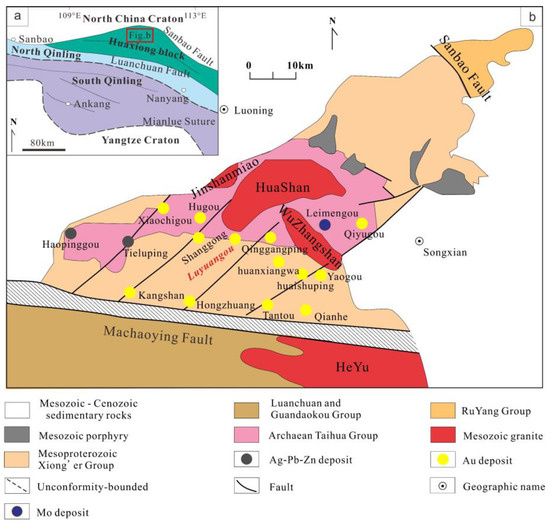
Figure 1.
(a) Simplified tectonic map of the Qinling Orogen. (b) Geological map and gold deposits of the Xiong’ershan region (modified from [7]).
The Luyuangou gold deposit is representative of the XESPMD and is characterized by thin quartz veins with significant economic value. More than 20 tons of gold has been extracted there since its discovery in 1998 [26]. The Luyuangou deposit is characterized as a multistage metallogenic deposit, and pyrites of different stages are present, providing an ideal object for studying the source, evolution, and precipitation mechanism of the ore-forming fluids in the XESPMD. In this study, the structural characteristics of pyrites from different generations in the Luyuangou deposit were identified by field investigations and a petrographic study. In addition, in situ LA-(MC)-ICP-MS analysis was utilized to analyze the trace elements and sulfur isotopes of the different pyrite generations. The results provide new insight into the origin and evolution of ore-forming fluids of the gold deposits in the XESPMD.
2. Geological Setting
The North China Craton (NCC), one of the oldest continental nuclei in the world and the largest craton block in China, contains large-scale gold and other metal deposits [27]. Influenced by the subduction of the Paleo-Pacific plate, the North China Craton (NCC) underwent intense destruction during the Mesozoic, which triggered intense magmatism, tectonism, and thermal events [28].
The Qinling orogenic belt (QOB) is the eastern prolongation of the E–W-trending Central China Orogenic Belt, which was formed by multiple stages of collision and subduction between the North China Craton and the Yangtze Craton during the Paleozoic and the Mesozoic [29,30]. The QOB consists of four tectonic units, which are, from north to south, the southern margin of the North China Craton (S-NCC), the North Qinling Belt (NQB), the South Qinling Belt (SQB), and the northern margin of the Yangtze Craton (N-SYC) [7,8], which are separated by the Luanchuan Suture Zone, the Shangdan Suture Zone, and the Mianliu Suture Zone (Figure 1a), respectively [7,31,32].
The Xiong’ershan Au-Ag polymetallic district (XESPMD) is located in the middle section of the East Qinling Metallogenic Belt (EQMB) along the S-NCC and is delimitated by the Luoning Fault in the north and the Machaoying Fault in the south. The district is rich in mineral resources, with Au, Ag, Mo, Pb, Zn, and other metal deposits [33,34]. The strata in the XESPMD comprise Neoarchean–Paleoproterozoic metamorphic rock units termed the Taihua Group, Mesoproterozoic volcanic rock units called the Xiong’er Group, Meso- to Neoproterozoic marine sedimentary rock units called the Guandaokou Group, and Cenozoic sedimentary rock units (Figure 1b). The structures mainly constitute faults, classified as NE-NNE striking faults, SN striking faults, EW striking faults, and NW striking faults. The EW and NE striking faults are widely developed and are the main ore-bearing structures in the area. The size of the faults varies from several hundred meters to several thousand meters in length, and several tens of centimeters to several tens of meters in width, showing the characteristics of early compression and late extension [7]. The area shows multiple phases of magmatic activities, mainly Archean intermediate–basic volcanic rocks, Mesoproterozoic volcanic rocks, and Mesozoic granites. Mesozoic magmatic activities are closely related to the formation of polymetallic minerals in the region [5,6]. Mesozoic granites include the Wuzhangshan pluton (157 ± 1 Ma [35]), the Heyu pluton (134.5 ± 1.5 Ma [36]), the Leimengou pluton (131.0 ± 0.6 Ma [2]), and the Haoping pluton (128.7~129.3 Ma) and the Jinshanmiao pluton (127.6 ± 1.6 Ma) in the Huashan complex pluton [37].
3. Geology of the Deposits
The Luyuangou gold deposit is situated on the northern slope of the eastern Xiong’er Mountain. The exposed strata in the deposit comprise the Taihua Group and the Xiong’er Group, which host the ore bodies (Figure 2).
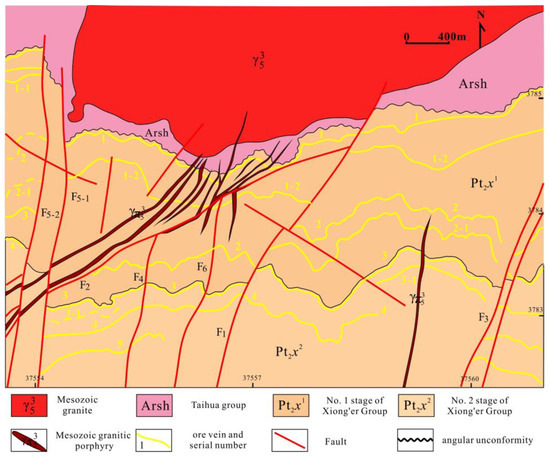
Figure 2.
Schematic geological map of the Luyuangou gold deposit.
The deposit’s structures are dominated by faults that strike in three directions (NE–NNE, EW, and NW). The majority of the faults strike in the NE–NNE and EW directions. A few faults strike NW and crosscut the NE-trending faults and veins. The NE–NNE-trending faults dip at 70–80° and represent the channel through which hydrothermal fluids have circulated [26]. The EW-trending faults have developed along the interlayer interfaces of the Xiong’er Group and dip at 20–45°, and they contain the ore bodies. The Huashan intrusion, a Yanshanian granite, is an outcrop with an ellipsoidal shape in the northern part. Many NE–NNE-trending dykes of syenogranite porphyry intercalate the Xiong’er Group, causing slight displacement of the gold-bearing veins (Figure 2).
The Luyuangou deposit consists of nine gold-bearing veins. Veins Nos. 1, 2, and 3 are the most exploited and are located in the E–W-trending fault (Figure 2), with a length of ~1000–3200 m and a width of ~0.2–1.5 m, and they dip to ~160–210° at angles of 25–45°. The most prominent vein, No. 2, has a length of ~2900 m; the vertical elevation ranges from 415 m to 1100 m with a thickness of 0.04–1.23 m. The Au grade ranges from 1 to 96.30 g/t, with an average of 8.20 g/t.
The ore mineral assemblage of the Luyuangou deposit includes pyrite, chalcopyrite, sphalerite, galena, gold, and electrum. The main gangue minerals are feldspar, quartz, chlorite, calcite, fluorite, and barite (Figure 3, Figure 4, Figure 5 and Figure 6). The wall-rock alteration is well developed, including silicification, potassicization, sericitization, pyritization, chloritization, and carbonatization (Figure 4e,f).
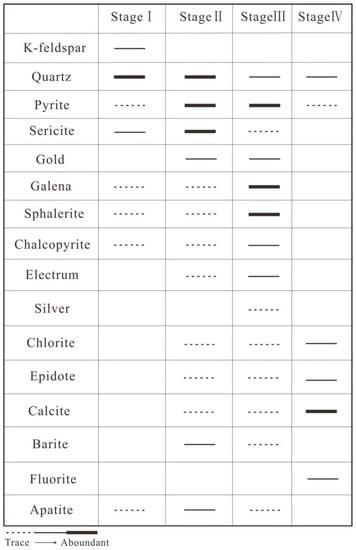
Figure 3.
Paragenetic sequence of the ore minerals of the Luyuangou gold deposit.
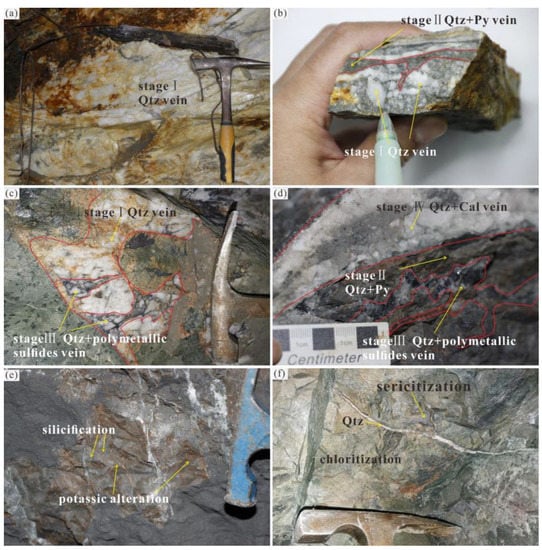
Figure 4.
Typical photographs from the Luyuangou gold deposit. (a) a Stage I quartz vein; (b) a Stage I quartz vein crosscut by a Stage Ⅱ quartz + pyrite vein; (c) a Stage I quartz vein crosscut by a Stage Ⅲ quartz + polymetallic sulfide vein; (d) interspersed relationships of the three metallogenic stages; (e,f) Wall-rock alterations of silicification, potassic, sericitization, and chloritization. Qtz, quartz; Py, pyrite; Cal, calcite.
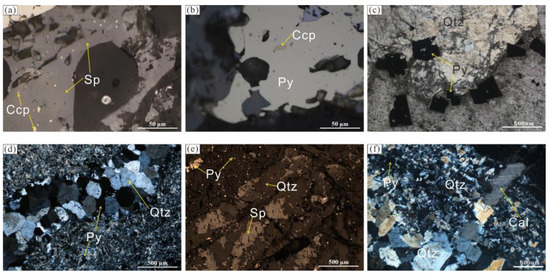
Figure 5.
Representative micrographs of the ore in the Luyuangou gold deposit. (a) Chalcopyrite is enclaved in sphalerite (reflected light). (b) Chalcopyrite is enclaved in pyrite (reflected light). (c) Coarse-grained quartz and euhedral pyrite. (d) Quartz–pyrite veins crosscutting through the altered rock. (e) Quartz sulfide veins crosscutting through the pyritized altered rocks (reflected light). (f) A quartz pyrite vein (Ⅱ) is crosscut by a quartz calcite vein (Ⅳ). Ccp, chalcopyrite; Qtz, quartz; Py, pyrite; Sp, sphalerite; Cal, calcite.
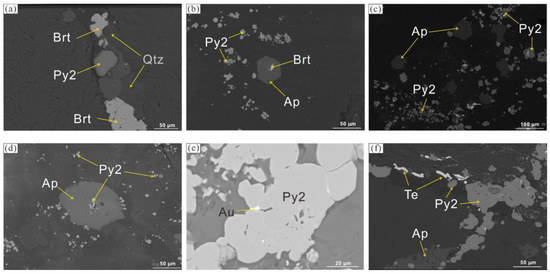
Figure 6.
Representative backscattered electron (BSE) images of the ore in the Luyuangou gold deposit. (a) Barite in a quartz pyrite vein (Ⅱ). (b) Barite enclaved in apatite. (c) Apatite in a quartz pyrite vein (Ⅱ). (d) Pyrite enclaved in apatite. (e) Gold occurring in the cracks of pyrite. (f) Tellurium in a quartz pyrite vein (Ⅱ). Qtz, quartz; Py, pyrite; Brt, barite; Ap, apatite; Te, tellurium; Au, gold.
On the basis of its paragenetic sequence and mineral assemblage (Figure 3), the Luyuangou gold deposit is divided into four mineralization stages: the milky quartz stage (Stage I), the quartz + pyrite stage (Stage II), the quartz + polymetallic sulfide stage (Stage III), and the quartz + calcite stage (Stage IV) (Figure 4, Figure 5 and Figure 6). Stage I is characterized by coarse-grained cubic pyrite in milky quartz veins (Figure 4a and Figure 5c). Stage II is fine-grained pyrite disseminated in altered rocks (Figure 4b,d). Stage III is identified by polymetallic sulfide veins (such as pyrite, sphalerite, galena, and chalcopyrite) crosscutting Stage I and Stage II (Figure 4c,d). Stage IV is characterized by quartz and calcite veins cutting through Stages I, II, and III (Figure 4d). Stages II and III are the major metallogenic stages.
4. Samples and Analytical Methods
4.1. Samples and Pyrite Types
Thirty-five samples, all intensively hydrothermally altered ores from four mineralization stages, were collected from the underground tunnels of Vein No. 2 in the Luyuangou gold deposit. Each sample was processed into thin sections for a detailed petrographic study. Typical samples (Table S1) were selected for in situ analyses of their trace elements and sulfur isotopes by LA-ICP-MS and LA-MC-ICP-MS, respectively.
Pyrite is the dominant sulfide in the four stages of the Luyuangou gold deposit. Five generations of pyrite were identified by optical microscopy. The first type (Py1-1) is a nucleus of medium- to coarse-grained euhedral cubic pyrite with numerous separate mineral phases such as galena and sphalerite (Figure 7a,b). The second type (Py1-2) is an edge of medium- to coarse-grained cubic pyrite with a homogeneous structure (Figure 7a,b). The third type (Py2) is fine-grained pyrite with porous structures and numerous mineral inclusions (such as sphalerite and galena) disseminated in altered rocks (Figure 7c,d). The fourth type (Py3) coexists with galena and sphalerite in the Stage III quartz sulfide veins (Figure 7e). The fifth type (Py4) is irregular pyrite in Stage IV quartz + calcite veins (Figure 7f).
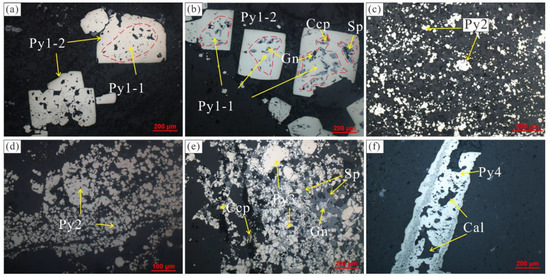
Figure 7.
Reflected light photomicrographs reflecting the textures of the different pyrite types. (a,b) Coarse-grained pyrite (Py1) in Stage I. (c,d) Fine-grained disseminated pyrite (Py2) in Stage Ⅱ. (e) Pyrite (Py3) in sulfide veins (Stage III). (f) Pyrite (Py4) in calcite veins (Stage IV). Ccp, chalcopyrite; Py, pyrite; Sp, sphalerite; Gn, galena; Cal, calcite.
4.2. SEM Analysis
Scanning electron imaging of thin sections was performed at the Collaborative Innovation Center for Strategic Mineral Resources Exploration of China’s University of Geosciences (Wuhan) using a JEOL JCM-7000 instrument equipped with EDS. High-resolution images of the minerals were obtained by a BSE detector at 15 kV and were used to observe the pyrite’s internal structure and to select sites for in situ tests of the trace elements and isotopes.
4.3. In Situ Analysis of Trace Elements
The in situ analysis of the trace elements of pyrite was carried out by LA-ICP-MS at Sample Solution Analytical Technology Co. Ltd., Wuhan, China. The details of the instrument’s parameters and the analytical procedure are the same as those described by Zong et al. [38]. The laser beam’s spot and frequency were 32 µm and 5 Hz, respectively. Standard glass material (NIST 610 and NIST 612) was used to calibrate the composition of the trace elements of sulfides without an internal standard. Standard USGS sulfide materials (MASS-1) were used to monitor the reliability of the calibration method for the specimens. The analytical data were processed offline using the ICPMSDataCal software [39].
4.4. In Situ Analysis Sulfur Isotopes
The in situ analysis of the sulfur isotopes of pyrite was carried out at the State Key Laboratory of Geological Processes and Mineral Resources (GPMR) at China’s University of Geosciences (Wuhan) using a Nu Plasma II LA-MC-ICP-MS mass spectrometer and a RESOlution-S155 193 nm excimer laser exfoliation system. The laser parameters used in this study were as follows: energy density, 3 J/cm2; beam spot, 33 µm; and frequency, 10 Hz. Instrument drift and mass deviation were corrected using a standard sample (pyrite, WS-1; sphalerite, NBS-123). The data acquisition was carried out in TRA mode with a background acquisition time of 30 s, a sample integration time of 50 s, and a purge time of 75 s. The details of the test procedure were described by Li et al. [40].
5. Results
5.1. Trace Elements in Pyrite
The in situ LA-ICP-MS analysis of pyrite from the Luyuangou gold deposit was carried out on 109 points, including 11 points in Py1-1, 15 points in Py1-2, 38 points in Py2, 24 points in Py3, and 21 points in Py4. The analytical elements included Ti, V, Cr, Mn, Co, Ni, Cu, Zn, As, Mo, Ag, Sb, Ba, W, Au, Pb, and Bi. The results are shown in Table 1.

Table 1.
Concentrations of trace elements (ppm) in pyrite from the Luyuangou gold deposit.
The Au and Ag contents in the pyrite gradually increased from Py1 to Py2 and Py3. In Py1, the Au contents ranged from 0 to 1.84 ppm with a mean value of 0.09 ppm, and the Ag contents ranged from 0 to 171.9 ppm with a mean value of 14.8 ppm. In Py2, the Au contents ranged from 0–21.4 ppm with a mean value of 3.7 ppm, and the Ag contents ranged from 0.8–1162 ppm with a mean value of 108.7 ppm. Py3 had the highest Au and Ag contents, ranging from 0.3 to 75.9 ppm (mean value of 6.2 ppm) and 0.2–347.6 ppm (mean value of 91.4 ppm), respectively. Py4, similar to Py1, had low Au and Ag contents, with ranges of 0–0.4 ppm (mean value of 0.08 ppm) and 0–80.4 ppm (mean value of 14 ppm), respectively (Figure 8).
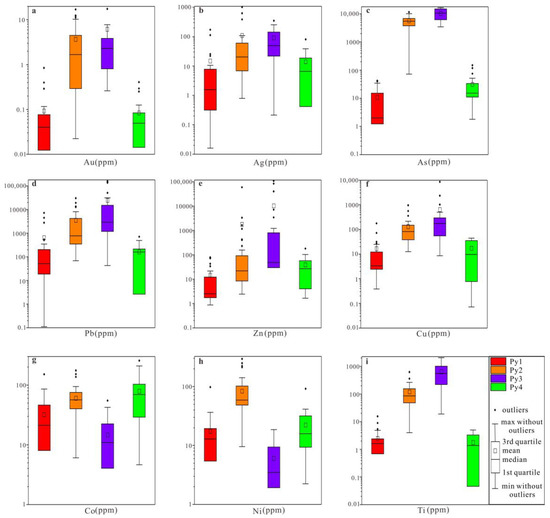
Figure 8.
Box plots of the concentrations of trace elements for each pyrite type from the Luyuangou gold deposit. (a) Concentrations of Au elements of pyrite from different generations. (b) Concentrations of Ag elements of pyrite from different generations. (c) Concentrations of As elements of pyrite from different generations. (d) Concentrations of Pb elements of pyrite from different generations. (e) Concentrations of Zn elements of pyrite from different generations. (f) Concentrations of Cu elements of pyrite from different generations. (g) Concentrations of Co elements of pyrite from different generations. (h) Concentrations of Ni elements of pyrite from different generations. (i) Concentrations of Ti elements of pyrite from different generations.
Arsenic, Pb, and Zn were the most abundant trace elements in the pyrite of the Luyuangou deposit. The concentration of As ranged from 0 to 16,706.8 ppm, Pb ranged from 0 to 159,346 ppm, and Zn ranged from 0 to 109,036 ppm, spanning at least five orders of magnitude (Table S1). Py1 and Py4 had low As (0–42.2 ppm and 1.8–149.1 ppm, respectively), Pb (0.1–7208 ppm and 0–708 ppm, respectively), and Zn contents (0.9–79 ppm and 1.7–182 ppm, respectively). Py2 and Py3 had high As contents (72.6–11,612 ppm and 3464.8–16,707 ppm, respectively), Pb contents (68.6–30,088 ppm and 42.8–159,346 ppm, respectively), and Zn contents (2.4–60,283 ppm and 0–109,036 ppm, respectively) (Figure 8).
In addition, Co, Ni, and Ti were also key trace elements in pyrite. Py4 had the highest Co contents (an average value of 79 ppm), whereas Py3 had the lowest Co contents (an average value of 14.6 ppm). Py2 displayed the highest Ni contents (an average value of 83.8 ppm), while Py3 had the lowest contents (an average value of 6 ppm). Py2 showed the highest Ti contents (an average value of 896.2 ppm); in contrast, Py3 displayed the lowest contents (an average value of 17.7 ppm) (Figure 8).
The differences in the trace elements between the edge and core in Py1 were insignificant (<1 order of magnitude). Therefore, the edge and core of Py1 are not discussed separately below. However, the presence of a large number of sulfide mineral phases such as sphalerite and galena in the Py1 core can easily lead to trace element anomalies such as Pb, Zn, and As (Table S1). Other generations of pyrite were smaller in size (2–40 μm); the core and edge could not be independently laser exfoliated. Therefore, the results of other generations of pyrite represent the “whole” pyrite (Table S1).
5.2. Sulfur Isotope Results
In total, 42 points were analyzed for sulfur isotopes in the 4 stages of pyrite (Table S2), including 5 points in Py1-1, 6 points in Py1-2, 14 points in Py2, 9 points in Py3, and 8 points in Py4. The δ34S values of all pyrites ranged from −19.5 to 3.4‰. The δ34S values of Py1 ranged from −0.3 to 1.9‰ (with no significant difference between the core and edge), and the δ34S values of Py2, Py3, and Py4 ranged from −15.4 to −6.1‰, from −19.5 to −12.4‰, and from 1.1 to 3.4‰, respectively (Figure 9).

Figure 9.
Histogram of the composition of sulfur isotopes of pyrites from the Luyuangou gold deposit.
6. Discussion
6.1. Occurrence and Distribution of Trace Elements in Pyrite
The trace elements in pyrite occur mainly in three forms: (1) solid solutions in the pyrite lattice [41], (2) invisible sulfide nanoparticles [42], and (3) micro-sized mineral inclusions [33,43,44,45].
Trace elements such as Co, Ni, As, Se, and Sb are commonly distributed in pyrite. Cobalt and Ni can replace Fe through isomorphism, while As, Se, and Sb can replace S to enter the pyrite lattice. In the LA-ICP-MS time-resolved depth profiles, most samples showed flat signal patterns for the elements Co, Ni, and As, consistent with Fe (Figure 10), suggesting that these elements appeared in the pyrite lattice through isomorphism [45]. However, the presence of “peaks” in some samples indicated that some of these elements were also present as micro/nanomineral inclusions (Figure 10a,g) [44]. Copper, Pb, and Zn cannot enter the pyrite lattice by replacing Fe during the mineralization process. Therefore, these elements are usually present in pyrite as mineral inclusions (galena, sphalerite, and chalcopyrite) [46]. Lead and Zn showed abnormal concentrations in all four pyrite stages, with the content varying from below the detection line to several hundred thousand parts per million (Table S1). We suggest that Pb and Zn are distributed as mineral phases in Py1 and as micron/nanometer inclusions in Py2, Py3, and Py4, causing anomalies in the elemental content (Figure 10). Some samples with flat time-resolved depth profiles (Figure 10e, f, h) indicated that small amounts of Pb and Zn were also present in the pyrite lattice as solid solutions (Table S1).
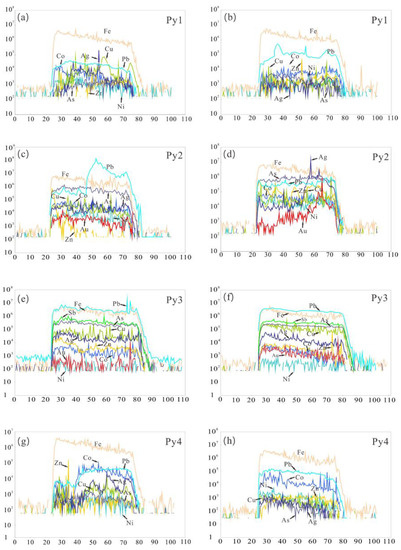
Figure 10.
Representative time-resolved depth profiles of pyrite analyzed in this study, indicating the occurrence of major metal elements. Iron has a relatively flat principal element response, indicating homogeneous pyrite. (a) The spiky peaks of Cu, Co, Ni, and As indicating the presence of micron/nanometer inclusions. (b,c) The spiky signal of Cu, Pb, Zn, and Ag indicating the presence of Cu–Pb–Zn–Ag micron/nanometer inclusions. (d) The spiky signal of Au and Ag indicating the presence of Au–Ag micron/nanometer inclusions. (e,f) Silver, Sb, and Pb displayed consistent trends. (g) The spiky peaks of Co, Pb, and Ag indicating the presence of micron/nanometer inclusions. (h) The flat signal of Pb, Zn indicating the presence of Pb–Zn solid solutions. See the text for further explanations.
Silver, Sb, and Pb displayed consistent trends in Py3 (Figure 10e,f) and had a positive correlation (Figure 11d,e), suggesting that Ag may be present in galena as an inclusion of natural Ag and Ag–Sb compounds (e.g., argyrythrose) [47]. A positive correlation also existed between Ag and Cu (Figure 11c), indicating that Ag can undergo a solid-state exchange reaction with Cu to form argentiferous chalcopyrite [7].
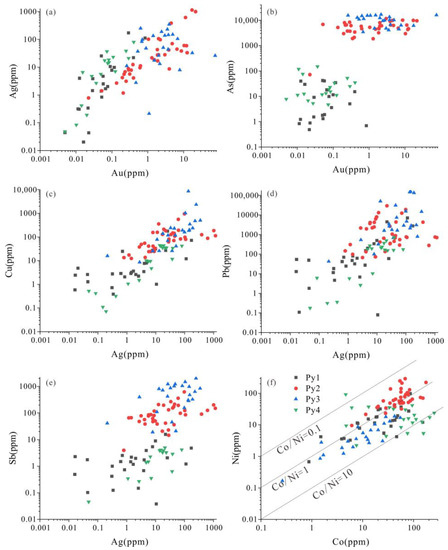
Figure 11.
Binary plots of (a) Au vs. Ag, (b) Au vs. As, (c) Ag vs. Cu, (d) Ag vs. Pb, (e) Ag vs. Sb, and (f) Co vs. Ni in different stages of pyrite.
Undulating signals with multiple peaks in the LA-ICP-MS time-resolved depth profile of Au indicated that Au was present in the Py2 and Py3 pyrites as tiny or submicroscopic inclusions of discrete gold-bearing phases (Figure 10c–f). Figure 11a shows a positive correlation between Au and Ag, indicating that Au may also exist in the form of electrum. Py2 and Py3 had high concentrations of As (Figure 8c), and Au and As had a positive correlation (Figure 11b), indicating that the precipitation of Au complexes was accompanied by high arsenic concentrations [48].
6.2. Sources of Sulfur Sources
The sulfur isotope compositions of sulfide minerals are widely used as a tracer of the origin of sulfur and the related physicochemical conditions that prevailed in ore deposits [49,50]. The δ34S values measured in the different pyrite generations of the Luyuangou gold deposit showed a wide range (Figure 9). The δ34S values of Py1 oscillated from −0.3 to 1.9‰, with an average of 0.8‰, indicating a mantle-like isotopic composition (0 ± 3‰) [7,51]. Moreover, the high Ag and Pb contents in the Py1 core (Figure 7a,b) indicated that the primary magmatic fluid was enriched in mineralized elements.
Py2 (−15.4 to −6.1‰) and Py3 (−19.5 to −12.4‰) had significantly negative δ34S values. Two possible reasons can explain the significantly negative value of δ34S. First, the sulfur in sulfides may come from the contribution of biological sulfur, which has significantly negative δ34S values [52,53]. In this case, the sulfur would come from the metamorphic devolatilization of sedimentary strata. Second is the isotopic fractionation caused by changes in temperature and the fugacity of oxygen [54]. The Xiong’er Group, built from volcanic rocks, lacks organic matter [12]. The Taihua Group also underwent intermediate to advanced metamorphism around 1850 Ma, when organic matter was transformed into sulfur-free graphite [12]. Therefore, providing biological sulfur to satisfy the mineralized system is unrealistic. We consider that changes in the physicochemical conditions of the ore-forming fluid may account for the negative δ34S values of Py2 and Py3. Pyrite is estimated to be 1.5‰ heavier than H2S at 250 °C, and the fractionation of pyrite and H2S is approximately 1.9‰ at 180 °C [53,54]. A 70 °C change in the temperature of the fluid can result in a 0.4‰ increase in pyrite’s δ34S. In the Luyuangou deposit, the homogenization temperatures of the fluid inclusion gradually decreased by 42 °C and 65 °C (averages of 320 °C, 278 °C, and 222 °C for Stages I, II, and III, respectively; unpublished data). Therefore, the decrease in temperature alone cannot explain the decrease in the δ34S ratios in Py2 and Py3 [54].
More significant changes in the δ34S ratio can be caused by changes in the oxygen fugacity of the fluid [53,54,55]. A large amount of barite and apatite (Figure 6a–d) was found in Stage II of mineralization, indicating the elevated oxygen fugacity of the metallogenic fluid (Figure 12). Because the 34S-O bond is stronger than the 32S-O bond, fluid oxidation leads to fractionation of the heavy 34S to sulfur oxide, which causes the ore-forming fluid to lose 34S and precipitates pyrite with a negative δ34S [27]. It is noteworthy that a series of gold deposits such as Shanggong, Huanxiangwa, and Qianhe in the XESPMD have similar 34S values of pyrite (Figure 13). This was interpreted as the mixing of meteoric water containing more free oxygen and high-valency cations, causing fluid oxidation [7,33,51,56]. The isotopic data of H and O in the XESPMD confirmed the addition of meteoric water during the main mineralization period (Figure 14). However, the H and O isotopes of Luyuangou gold deposit are not clear, and so they cannot provide more obvious evidence. We plan to further confirm our idea by studying the in situ O isotopes of quartz.
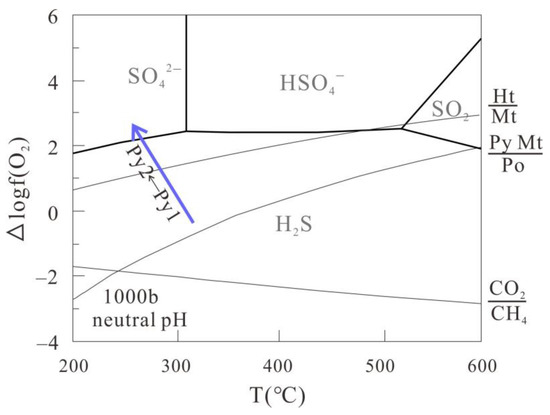
Figure 12.
Log fO2–pH diagram showing the stability of the relationships in the Fe–O–S system at 1000 bars and a neutral pH. The direction of the evolution of fluid in the Luyuangou gold deposit is indicated by the blue arrow (modified from [57]).
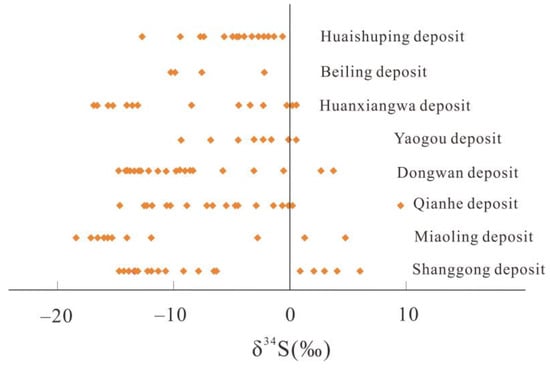
Figure 13.
Characteristics of 34S distribution in pyrite of gold deposits in the XESPMD (modified from [58]).
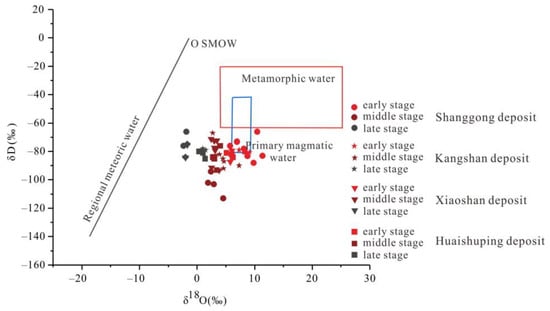
Figure 14.
The δD and δ18O characteristics of the fluid of gold deposits in the XESPMD (data from Shanggong [59], Kangshan [1], Xiaoshan [60], and Huaishuping [61]).
The δ34S values of Py4 showed slightly positive values ranging from 1.1 to 3.4‰, which were similar to the strata of the Taihua Group (0‰–6‰) and the Xiong’er Group (2‰–6‰) [13], indicating that the sulfur originated from the host rocks under the action of the meteoric water cycle [56].
6.3. Evolution of Ore-Forming Fluids
The ratio of Co to Ni in pyrite is not only indicative of the pyrite’s genesis but also of the characteristics of the ore-forming fluid [33,62]. Generally, magmatic–hydrothermal pyrites are characterized by Co/Ni ratios >1 [63,64]. The dominant Co/Ni values in Py1, Py3, and Py4 were >1 (Figure 11f), suggesting that the pyrite is of hydrothermal origin [33,64]. Py2 had Co/Ni values of <1 and negative δ34S values (−15.4 to −6.1‰), indicating the possible input of meteoric water in Stage II [33].
Based on the composition of trace elements and the characteristics of the in situ sulfur isotopes of the different types of pyrite, the evolution of ore-forming fluids can be summarized as follows. First, the coarse-grained cubic pyrite (Py1) in Stage I was formed by the migration of mantle-derived magma enriched in mineralized elements. Because of the high fluid temperature, slow cooling, and slow mineral growth, trace elements such as Pb, Zn, and Cu were incorporated into the Py1 as separate mineral phases (Py1-1) rather than as solid solutions or tiny inclusions (<5 μm) [44,65]. Thus, Py1 had fewer mineral inclusions than Py2 and Py3. Next, with the mixing of meteoric water, the physicochemical conditions of the ore-forming fluid changed (e.g., lower temperature and higher oxygen fugacity), and isotope fractionation occurred [13]. The ore-forming material was rapidly precipitated, and the trace elements were dissolved into Py2 and Py3 as solid solutions or tiny inclusions (<5 μm) [51]. Therefore, Py2 and Py3 precipitated as fine or faceted grains, with abundant galena, chalcopyrite, and sphalerite inclusions and significantly negative δ34S values. Lastly, as the thermal energy and material decreased, the ore-forming fluid gradually transitioned to meteoric water, forming a series of low-temperature carbonate minerals and Py4.
7. Conclusions
- (1)
- Four mineralization stages of pyrite in the Luyuangou gold deposit were identified: coarse-grained euhedral cubic pyrite (Py1) in milky quartz veins (Stage I), fine-grained disseminated pyrite (Py2) in altered rocks (Stage Ⅱ), pyrite (Py3) that was coeval with galena and sphalerite in quartz + polymetallic sulfide veins (Stage Ⅲ), and irregular pyrite (Py4) in quartz + calcite veins (Stage Ⅳ).
- (2)
- Metallic elements such as Au, Ag, Cu, Pb, and Zn were mainly present in pyrite as micro/nanoscale mineral inclusions. Trace elements such as Co, Ni, As, Se, and Sb replaced Fe and S in the pyrite lattice in the form of isomorphisms.
- (3)
- The δ34S values of Py1 ranged from −0.3 to 1.9‰, indicating a magmatic origin. The δ34S values of Py2 and Py3 ranged from −15.4 to −6.1‰ and −19.5 to −12.4‰, respectively, indicating an origin from oxidizing fluids. The δ34S values of Py4 ranged from 1.1 to 3.4‰, indicating that the S originated from host rocks under the action of meteoric water cycles.
- (4)
- The characteristics of the trace elements and sulfur isotopes of pyrite indicated that the ore-forming fluid in the Luyuangou gold deposit was of magmatic origin and enriched in mineralizing elements. The fluid mixed with meteoric water during the main mineralization period, which modified its physicochemical conditions and caused the precipitation of a large amount of gold and other mineralized elements. Afterwards, the thermal energy of the fluids and materials decreased, and the fluid’s composition gradually transitioned to meteoric water.
Supplementary Materials
The following supporting information can be downloaded at: https://www.mdpi.com/article/10.3390/min13030407/s1, Table S1: LA-ICP-MS analyses of various pyrite generations from the Luyuangou gold deposit. Table S2: Composition of sulfur isotopes (‰) of various pyrite generations in the Luyuangou gold deposit.
Author Contributions
Conceptualization, F.S. and H.S.; field investigation, F.S., H.W., C.Z. and H.S.; experiments, F.S., D.W. and Q.Z.; writing—original draft preparation, F.S.; writing—review and editing, F.S., K.A.D.K. and H.S. All authors have read and agreed to the published version of the manuscript.
Funding
This research was funded by National Natural Science Foundation of China, grant number 41672074.
Institutional Review Board Statement
Not applicable.
Informed Consent Statement
Not applicable.
Data Availability Statement
Not applicable.
Acknowledgments
The Luoning Huatai Mining Development Co., Ltd., is thanked for their help with the field investigation and in collecting the material samples.
Conflicts of Interest
The authors declare no conflict of interest.
References
- Zhang, Z.M.; Zeng, Q.D.; Guo, Y.P.; Wang, R.L.; Yang, J.H.; Chen, Y.K. Genesis of the Kangshan Au-polymetallic deposit, Xiong’ershan District, North China Craton: Constraints from fluid inclusions and C-H-O-S-Pb isotopes. Ore Geol. Rev. 2020, 127, 103815. [Google Scholar] [CrossRef]
- Cao, J.; Ye, H.S.; Chen, X.D.; Li, Z.Y.; Zhang, X.K.; He, W. Geochronology, geochemistry and Sr-Nd-Hf isotopic compositions of granite porphyry in Leimengou Mo deposit, western Henan Province. Miner. Depos. 2016, 35, 677–695, (In Chinese with English abstract). [Google Scholar]
- Cao, M.P.; Yao, J.M.; Deng, X.H.; Yang, F.J.; Mao, G.Z.; Mathur, R. East Qinling: From Triassic Cu mineralization. Ore Geol. Rev. 2017, 81, 565–574. [Google Scholar] [CrossRef]
- Gao, X.Y.; Zhao, T.P.; Yuan, Z.L.; Zhou, Y.Y.; Gao, J.F. Geochemistry and petrogenesis of the Heyu batholith in the southern margin of the North China block. Acta Petrol. Sin. 2010, 26, 3485–3506, (In Chinese with English abstract). [Google Scholar]
- Tang, K.F.; Li, J.W.; Selby, D.; Zhou, M.F.; Bi, S.J.; Deng, X.D. Geology, mineralization, and geochronology of the Qianhe gold deposit, Xiong’ershan area, southern North China Craton. Miner. Deposita. 2013, 48, 729–747. [Google Scholar] [CrossRef]
- Tang, L.; Zhao, Y.; Zhang, S.T.; Sun, L.; Hu, X.K.; Sheng, Y.M.; Zeng, T. Origin and evolution of a porphyry-breccia system: Evidence from zircon U-Pb, molybdenite Re-Os geochronology, in-situ sulfur isotope and trace elements of the Qiyugou deposit, China. Gondwana Res. 2020, 89, 88–104. [Google Scholar] [CrossRef]
- Feng, J.Y.; Tang, L.; Santosh, M.; Zhang, S.T.; Sheng, Y.M.; Hu, X.K.; Wang, L. Genesis of hydrothermal gold mineralization in the Qianhe deposit, central China: Constraints from in-situ sulphur isotope and trace elements of pyrite. Geol. J. 2021, 56, 3241–3256. [Google Scholar] [CrossRef]
- Zhou, Z.J.; Chen, Y.J.; Jiang, S.Y.; Zhao, H.X.; Qin, Y.; Hu, C.J. Geology, geochemistry and ore genesis of the Wenyu gold deposit, Xiaoqinling gold field, Qinling Orogen, southern margin of North China Craton. Ore Geol. Rev. 2014, 59, 1–20. [Google Scholar] [CrossRef]
- Mao, J.W.; Goldfarb, R.J.; Zhang, Z.W.; Xu, W.Y.; Qiu, Y.M.; Deng, J. Gold deposits in the Xiaoqinling–Xiong’ershan region, Qinling Mountains, central China. Miner. Deposita. 2002, 37, 306–325. [Google Scholar] [CrossRef]
- Tian, Y.F.; Sun, J.; Ye, H.S.; Mao, J.W.; Wang, X.X.; Bi, M.F.; Xia, X.P. Genesis of the Dianfang breccia-hosted gold deposit, western Henan Province, China: Constraints from geology, geochronology and geochemistry. Ore Geol. Rev. 2017, 91, 963–980. [Google Scholar] [CrossRef]
- Wang, C.Y.; Wei, B.; Tan, W.; Wang, Z.C.; Zeng, Q.D. The distribution, characteristics and fluid sources of lode gold deposits: An overview. Sci. China Earth Sci. 2021, 64, 1463–1480. [Google Scholar] [CrossRef]
- Chen, Y.J.; Pirajno, F.; Sui, Y.H. Isotope geochemistry of the Tieluping silver-lead deposit, Henan, China: A case study of orogenic silver-dominated deposits and related tectonic setting. Miner. Deposita. 2004, 39, 560–575. [Google Scholar] [CrossRef]
- Chen, Y.J.; Pirajno, F.; Qi, J.P. The Shanggong gold deposit, Eastern Qinling Orogen, China: Isotope geochemistry and implications for ore genesis. Asian J. Earth Sci. J. Asian Earth Sci. 2008, 33, 252–266. [Google Scholar] [CrossRef]
- Zhou, D.; Zhao, T.P.; Zhao, P.L.; Zhang, X.T. Re-Os Dating for the Molybdenite from the Yaogou Gold Deposit West of Henan Province and Its Geological Significance. Bull. Geol. Sci. Technol. 2018, 37, 162–167, (In Chinese with English abstract). [Google Scholar]
- Gao, J.J.; Mao, J.W.; Chen, M.H.; Ye, H.S.; Zhang, J.J.; Li, Y.F. Vein Structure Analysis and ~(40)Ar/~(39)Ar Dating of Sericite from Sub-ore Altered Rocks in the Tieluping Large-size Ag-Pb Deposit of Western Henan Province. Acta Geol. Sin. 2011, 85, 1172–1187, (In Chinese with English abstract). [Google Scholar]
- Yang, J.H.; Wu, F.Y.; Wilde, S.A. A review of the geodynamic setting of large-scale Late Mesozoic gold mineralization in the North China Craton: An association with lithospheric thinning. Ore Geol. Rev. 2003, 23, 125–152. [Google Scholar] [CrossRef]
- Zhang, Z.M.; Zeng, Q.D.; Gao, S.; Chu, S.X.; Li, D.T.; Cheng, Z.D.; Ma, L.S.; Guo, Y.P. The Rb-Sr isotopic dating of sulfides and geological significance of the Lushi polymetallic ore-concentrated area in southern margin of the North China Craton. Acta Petrol. Sin. 2019, 35, 2013–2025, (In Chinese with English abstract). [Google Scholar]
- Chen, Y.; Fan, Y.; Zhou, T.F.; Fu, B.; Liu, Y.N.; Wang, B.; Liu, Q. Pyrite textures and compositions in Jiangshan gold deposit, Bengbu Uplift, southeastern North China Craton: Implications for ore genesis. Ore Geol. Rev. 2020, 122, 103512. [Google Scholar] [CrossRef]
- Yu, B.; Zeng, Q.D.; Frimmel, H.E.; Wang, Y.B.; Guo, W.K.; Sun, G.T.; Zhou, T.C.; Li, J.P. Genesis of the Wulong gold deposit, northeastern North China Craton: Constraints from fluid inclusions, H-O-S-Pb isotopes, and pyrite trace element concentrations. Ore Geol. Rev. 2018, 102, 313–337. [Google Scholar] [CrossRef]
- Deol, S.; Deb, M.; Large, R.R.; Gilbert, S. LA-ICPMS and EPMA studies of pyrite, arsenopyrite and loellingite from the Bhukia-Jagpura gold prospect, southern Rajasthan, India: Implications for ore genesis and gold remobilization. Chem. Geol. 2012, 326, 72–87. [Google Scholar] [CrossRef]
- Fielding, I.O.; Johnson, S.P.; Meffre, S.; Zi, J.; Sheppard, S.; Large, R.R.; Rasmusseng, B. Linking gold mineralization to regional-scale drivers of mineral systems using in-situ U-Pb geochronology and pyrite LA-ICP-MS element mapping. Geosci. Front. 2019, 10, 89–105. [Google Scholar] [CrossRef]
- Liu, G.Q.; Zhao, K.D.; Jiang, S.Y.; Chen, W. In-situ sulfur isotope and trace element analysis of pyrite from the Xiwang uranium ore deposit in South China: Implication for ore genesis. J. Geochem. Explor. 2018, 195, 49–65. [Google Scholar] [CrossRef]
- Wei, D.T.; Zhou, T.F.; Xia, Y.; Fan, Y.; Xie, Z.J.; Liu, X.J.; Tan, Q.P.; Bai, L.A.; Wang, F.Y. Pyrite textural, trace elemental and sulfur isotope signatures of the Badu gold deposit, Youjiang basin (SW China): Implications for ore-fluid source and Au precipitation mechanism. Ore Geol. Rev. 2022, 149, 105083. [Google Scholar] [CrossRef]
- Zhang, H.C.; Zhu, Y.F.; Salvi, S.; Wu, Y.F.; Gilbert, S. Complex fluid source of the multistage pyrite-bearing Huilvshan gold deposit (west Junggar, NW China): Insight from pyrite texture, sulfur isotope and trace element compositions. Ore Geol. Rev. 2022, 149, 105081. [Google Scholar] [CrossRef]
- Zhou, L.L.; Zeng, Q.D.; Sun, G.T.; Duan, X.X.; Bonnetti, C.; Riegler, T.; Long, D.G.F.; Kamber, B. Laser Ablation-Inductively Coupled Plasma Mass Spectrometry (LA-ICPMS) elemental mapping and its applications in ore geology. Acta Petrol. Sin. 2019, 35, 1964–1978, (In Chinese with English abstract). [Google Scholar]
- Lei, W.S.; Dai, J.; Zhao, T.P.; Zhang, Y.F.; Tao, N.; Yang, G. Field geology, geochronology, and isotope geochemistry of the Luyuangou gold deposit, China: Implications for the gold mineralization in the eastern Qinling Orogen. Geol. J. 2018, 53, 96–112. [Google Scholar] [CrossRef]
- Meng, L.; Lan, C.Y.; Zhan, Q.; Wu, Q.; Zhao, T.P. Origin of the Shanggong gold deposit, the southern margin of the North China Craton: Constraints from Rb-Sr ages of sericite, and trace elements and sulfur isotope of pyrite. Ore Geol. Rev. 2022, 142, 104728. [Google Scholar] [CrossRef]
- Yang, J.H.; Xu, L.; Sun, J.F.; Zeng, Q.; Zhao, Y.N.; Wang, H.; Zhu, Y.S. Geodynamics of decratonization and related magmatism and mineralization in the North China Craton. Sci. China Earth Sci. 2021, 64, 1409–1427. [Google Scholar] [CrossRef]
- Geng, J.Z.; Qiu, K.F.; Gou, Z.Y.; Yu, H.C. Tectonic regime switchover of Triassic Western Qinling Orogen: Constraints from LA-ICP-MS zircon U–Pb geochronology and Lu–Hf isotope of Dangchuan intrusive complex in Gansu, China. Geochemistry 2017, 77, 637–651. [Google Scholar] [CrossRef]
- Yang, L.M.; Song, S.G.; Allen, M.B.; Su, L.; Dong, J.L.; Wang, C. Oceanic accretionary belt in the West Qinling Orogen: Links between the Qinling and Qilian orogens, China. Gondwana Res. 2018, 64, 137–162. [Google Scholar] [CrossRef]
- Dong, Y.P.; Zhang, G.W.; Neubauer, F.; Liu, X.M.; Genser, J.; Hauzenberger, C. Tectonic evolution of the Qinling orogen, China: Review and synthesis. J. Asian Earth Ences. 2011, 41, 213–237. [Google Scholar] [CrossRef]
- Dong, Y.P.; Zhang, X.N.; Liu, X.M.; Li, W.; Chen, Q.; Zhang, G.W.; Zhang, H.F.; Zhao, Y.; Sun, S.S.; Zhang, F.F. Propagation tectonics and multiple accretionary processes of the Qinling Orogen. J. Asian Earth Sci. 2015, 104, 84–98. [Google Scholar] [CrossRef]
- Sheng, Y.M.; Tang, L.; Zhang, S.T.; Santosh, M.; Hu, X.K. Influence of fluid-rock interaction on gold mineralization in the Dongwan deposit, East Qinling, China: Constraints from systematic sulfur isotope and trace element geochemistry. Ore Geol. Rev. 2022, 142, 104718. [Google Scholar] [CrossRef]
- Tang, L.; Hu, X.K.; Santosh, M.; Zhang, S.T.; Spencer, C.J.; Jeon, H.; Zhao, Y.; Cao, H.W. Multistage processes linked to tectonic transition in the genesis of orogenic gold deposit: A case study from the Shanggong lode deposit, East Qinling, China. Ore Geol. Rev. 2019, 111, 102998. [Google Scholar] [CrossRef]
- Mao, J.W.; Xie, G.Q.; Pirajno, F.; Ye, H.S.; Wang, Y.B.; Li, Y.F.; Xiang, J.F.; Zhao, H.J. Late Jurassic-Early Cretaceous granitoid magmatism in Eastern Qinling, central-eastern China: SHRIMP zircon U-Pb ages and tectonic implications. J. Geol. Soc. Aust. 2010, 57, 51–78. [Google Scholar] [CrossRef]
- Guo, B.; Zhu, L.M.; Li, B.; Gong, H.J.; Wang, J.Q. Zircon U-Pb age and Hf isotope composition of the Huashan and Heyu granite plutons at the southern margin of North China Craton: Implications for geodynamic setting. Acta Petrol. Sin. 2009, 25, 265–281, (In Chinese with English abstract). [Google Scholar]
- Xiao, E.; Jian, H.; Zhang, Z.Z.; Dai, B.Z.; Li, H.Y. Petrogeochemistry, zircon U-Pb dating and Lu-Hf isotopic compositions of the Haoping and Jinshanmiao granites from the Huashan complex batholith in eastern Qinling Orogen. Acta Petrol. Sin. 2012, 28, 4031–4046, (In Chinese with English abstract). [Google Scholar]
- Zong, K.Q.; Klemd, R.; Yuan, Y.; He, Z.Y.; Guo, J.L.; Shi, X.L.; Liu, Y.S.; Hu, Z.C.; Zhang, Z.M. The assembly of Rodinia: The correlation of early Neoproterozoic (ca. 900Ma) high-grade metamorphism and continental arc formation in the southern Beishan Orogen, southern Central Asian Orogenic Belt (CAOB). Precambrian Res. 2017, 290, 32–48. [Google Scholar] [CrossRef]
- Liu, Y.S.; Hu, Z.C.; Gao, S.; Günther, D.; Xu, J.; Gao, C.J.; Chen, H.H. In-situ analysis of major and trace elements of anhydrous minerals by LA-ICP-MS without applying an internal standard. Chem. Geol. 2008, 257, 34–43. [Google Scholar] [CrossRef]
- Li, X.; Zhao, K.D.; Jiang, S.Y.; Palmer, M.R. In-situ U-Pb geochronology and sulfur isotopes constrain the metallogenesis of the giant Neves Corvo deposit, Iberian Pyrite Belt. Ore Geol. Rev. 2019, 105, 223–235. [Google Scholar] [CrossRef]
- Deditius, A.P.; Reich, M.; Kesler, S.E.; Utsunomiya, S.; Chryssoulis, S.L.; Walshe, J.; Ewing, R.C. The coupled geochemistry of Au and As in pyrite from hydrothermal ore deposits. Geochim. Cosmochim. Acta. 2014, 140, 644–670. [Google Scholar] [CrossRef]
- Ciobanu, C.L.; Cook, N.J.; Utsunomiya, S.; Kogagwa, M.; Green, L.; Gilbert, S.; Wade, B. Gold-telluride nanoparticles revealed in arsenic-free pyrite. Am. Mineral. 2012, 97, 1515–1518. [Google Scholar] [CrossRef]
- Sykora, S.; Cooke, D.R.; Meffre, S.; Stephanov, A.S.; Gardner, K.; Scott, R.; Selley, D.; Harris, A.C. Evolution of pyrite trace element compositions from porphyry-style and epithermal conditions at the Lihir gold deposit: Implications for ore genesis and mineral processing. Econ. Geol. 2018, 113, 193–208. [Google Scholar] [CrossRef]
- Zhang, J.; Deng, J.; Chen, H.Y.; Yang, L.Q.; Cooke, D.; Danyushevsky, L.; Gong, Q.J. LA-ICP-MS trace element analysis of pyrite from the Chang’an gold deposit, Sanjiang region, China: Implication for ore-forming process. Gondwana Res. 2014, 26, 557–575. [Google Scholar] [CrossRef]
- Zhou, C.; Yang, Z.; Sun, H.S.; Koua, K.A.D.; Lyu, C.L. LA-ICP-MS trace element analysis of sphalerite and pyrite from the Beishan Pb-Zn ore district, south China: Implications for ore genesis. Ore Geol. Rev. 2022, 150, 105128. [Google Scholar] [CrossRef]
- Fu, X.M.; Zhang, D.X.; Dai, T.G.; Gao, J.F. Trace Element Record of Pyrite from Diverse Deposits-Examples from the Dabaoshan Polymetallic Deposit of Northern Guangdong, South China. Geotecton. Metallog. 2018, 42, 505–519, (In Chinese with English abstract). [Google Scholar]
- Cook, N.J.; Spry, P.G.; Vokes, F.M. Mineralogy and textural relationships among sulphosalts and related minerals in the Bleikvassli Zn-Pb-(Cu) deposit, Nordland, Norway. Miner. Deposita. 1998, 34, 35–56. [Google Scholar] [CrossRef]
- Reich, M.; Kesler, S.E.; Utsunomiya, S.; Palenik, C.S.; Chryssoulis, S.L.; Ewing, R.C. Solubility of gold in arsenian pyrite. Geochim. Cosmochim. Acta. 2005, 69, 2781–2796. [Google Scholar] [CrossRef]
- Tomkins, A.G. Windows of metamorphic sulfur liberation in the crust: Implications for gold deposit genesis. Geochim. Cosmochim. Acta. 2010, 74, 3246–3259. [Google Scholar] [CrossRef]
- Labidi, J.; Cartigny, P.; Jackson, M.G. Multiple sulfur isotope composition of oxidized Samoan melts and the implications of a sulfur isotope ‘mantle array’ in chemical geodynamics. Earth Planet. Sci. Lett. 2015, 417, 28–39. [Google Scholar] [CrossRef]
- Sun, G.T.; Zeng, Q.D.; Zhou, L.L.; Wang, Y.B.; Chen, P.W. Trace element contents and in-situ sulfur isotope analyses of pyrite in the Baiyun gold deposit, NE China: Implication for the genesis of intrusion-related gold deposits. Ore Geol. Rev. 2020, 118, 103330. [Google Scholar] [CrossRef]
- Canfield, D.E.; Farquhar, J.; Zerkle, A.L. High isotope fractionations during sulfate reduction in a low-sulfate euxinic ocean analog. Geology 2010, 38, 415–418. [Google Scholar] [CrossRef]
- Ohmoto, H. Systematics of Sulfur and Carbon Isotopes in Hydrothermal Ore Deposits. Econ. Geol. 1972, 67, 551–578. [Google Scholar] [CrossRef]
- Ma, Y.; Jiang, S.Y.; Frimmel, H.E.; Zhu, L.Y. In situ chemical and isotopic analyses and element mapping of multiple-generation pyrite: Evidence of episodic gold mobilization and deposition for the Qiucun epithermal gold deposit in Southeast China. Am. Mineral. 2022, 107, 1133–1148. [Google Scholar] [CrossRef]
- Jorgensen, B.B. A theoretical model of the stable sulfur isotope distribution in marine sediments. Geochim. Cosmochim. Acta. 1979, 43, 363–374. [Google Scholar] [CrossRef]
- Hu, X.L.; He, M.C.; Yao, S.Z. New understanding of the source of ore-forming material and fluid in the Shanggong gold deposit, East Qinling. Acta Geol. Sin. 2013, 87, 91–100, (In Chinese with English abstract). [Google Scholar]
- Palin, J.M.; Xu, Y. Gilt by association? Origins of pyritic gold ores in the Victory mesothermal gold deposit, Western Australia. Econ Geol. 2000, 95, 1627–1634. [Google Scholar] [CrossRef]
- He, X.Y.; Wang, C.M.; Yuan, J.M.; Liu, J.; Liu, H.P. Mesozoic Au-Mo metallogenic system in the Xiong’ershan-Waifangshan ore field. Earth Sc. Front 2019, 26, 33–52, (In Chinese with English abstract). [Google Scholar]
- Chen, Y.J.; Pirajno, F.; Qi, J.P.; Li, J.; Wang, H.H. Ore Geology, Fluid Geochemistry and Genesis of the Shanggong Gold Deposit, Eastern Qinling Orogen, China. Resour. Geol. 2006, 56, 99–116. [Google Scholar] [CrossRef]
- Chen, J. Mesozoic Orogenic Gold Mineralization in the East Qinling Orogen. Ph.D. Thesis, China University of Geosciences, Beijing, China, 2018. (In Chinese with English abstract). [Google Scholar]
- Wang, C.M.; Deng, J.; Bagas, L.; He, X.Y.; Zhang, J. Origin and classification of the Late Triassic Huaishuping gold deposit in the eastern part of the Qinling-Dabie Orogen, China: Implications for gold metallogeny. Miner. Depos. 2021, 56, 725–742. [Google Scholar] [CrossRef]
- Cook, N.J.; Ciobanu, C.L.; Mao, J. Textural control on gold distribution in As-free pyrite from the Dongping, Huangtuliang and Hougou gold deposits, North China Craton (Hebei Province, China). Chem. Geol. 2009, 264, 101–121. [Google Scholar] [CrossRef]
- Cook, N.J. Mineralogy of the sulphide deposits at Sulitjelma, northern Norway. Ore Geol. Rev. 1996, 11, 303–338. [Google Scholar] [CrossRef]
- Wang, K.X.; Zhai, D.G.; Liu, J.J.; Wu, H. LA-ICP-MS trace element analysis of pyrite from the Dafang gold deposit, South China: Implications for ore genesis. Ore Geol. Rev. 2021, 139, 104507. [Google Scholar] [CrossRef]
- Butler, I.B.; Rickard, D. Framboidal pyrite formation via the oxidation of iron (II) monosulfide by hydrogen sulphide. Geochim. Cosmochim. Acta. 2000, 64, 2665–2672. [Google Scholar] [CrossRef]
Disclaimer/Publisher’s Note: The statements, opinions and data contained in all publications are solely those of the individual author(s) and contributor(s) and not of MDPI and/or the editor(s). MDPI and/or the editor(s) disclaim responsibility for any injury to people or property resulting from any ideas, methods, instructions or products referred to in the content. |
© 2023 by the authors. Licensee MDPI, Basel, Switzerland. This article is an open access article distributed under the terms and conditions of the Creative Commons Attribution (CC BY) license (https://creativecommons.org/licenses/by/4.0/).